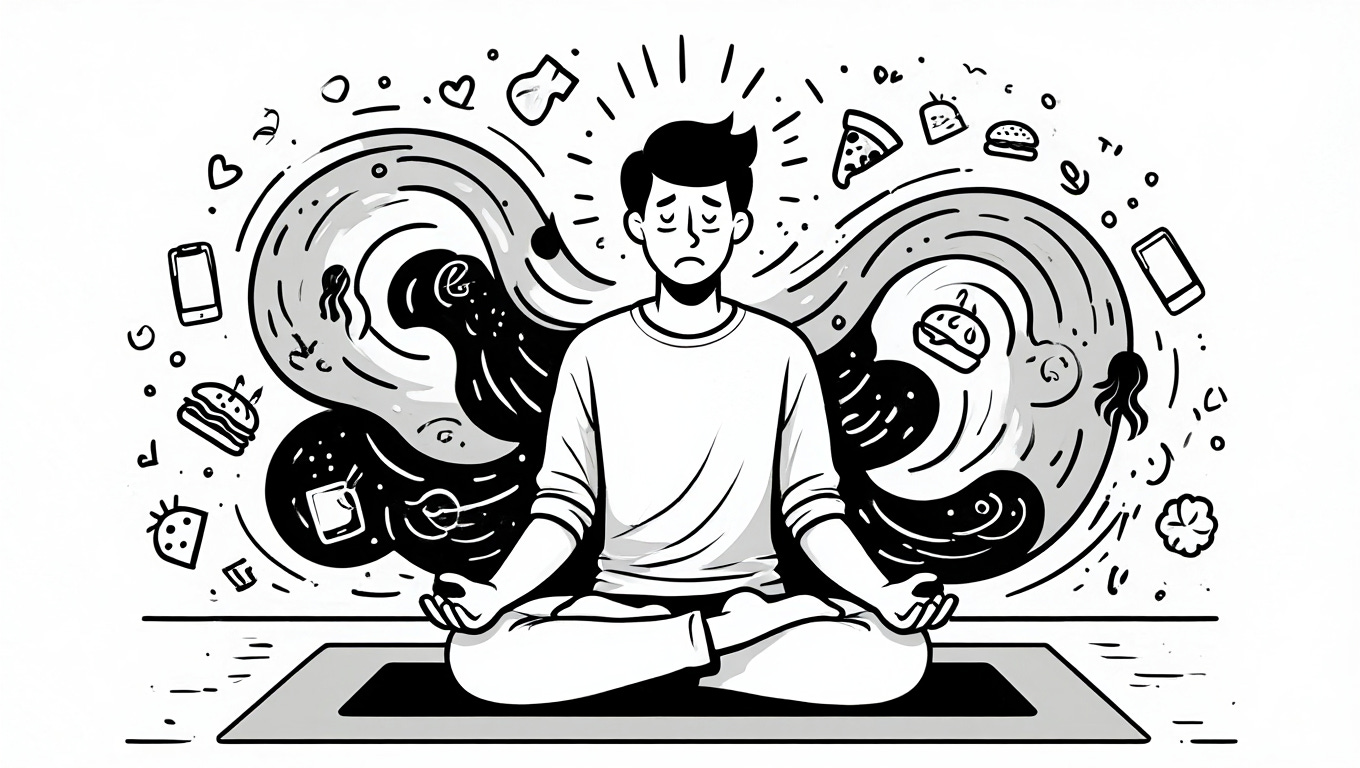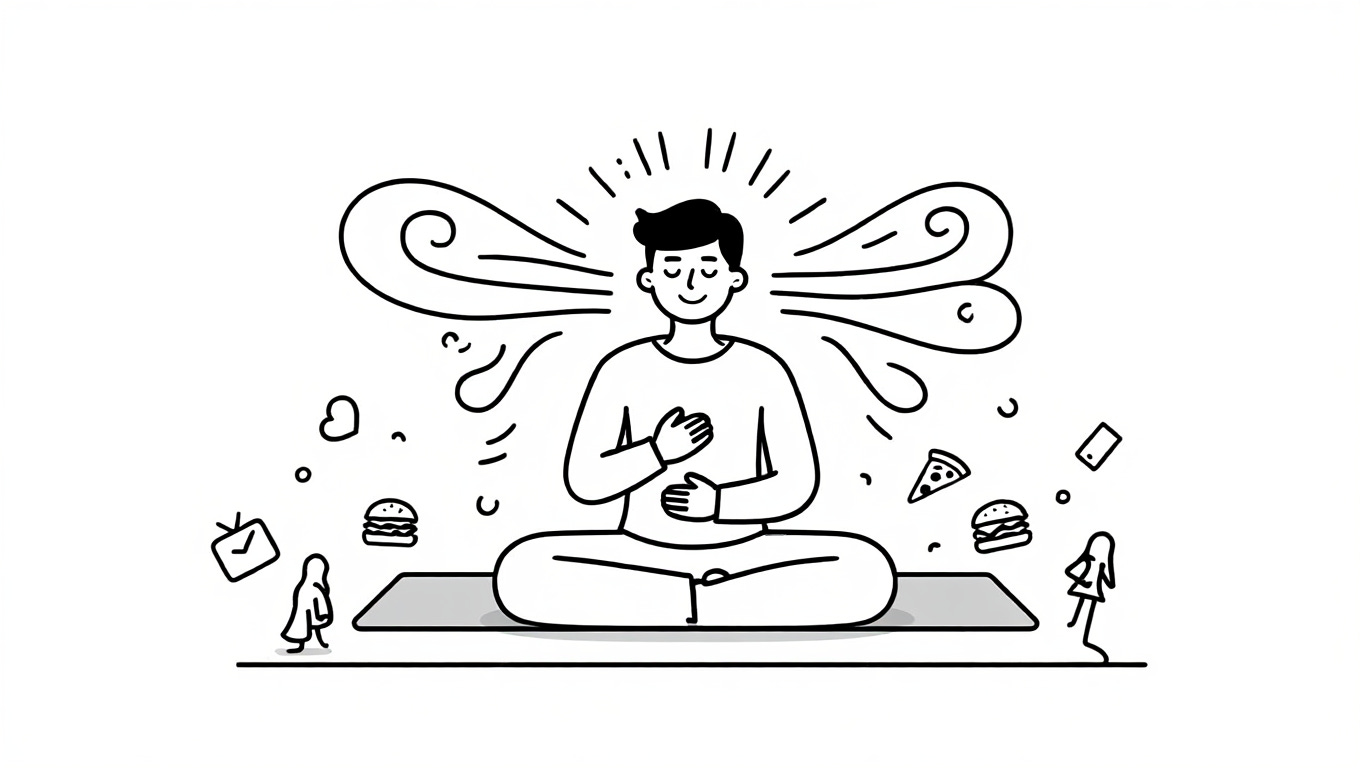Sutra 1.34
प्रच्छर्दनविधारणाभ्यां वा प्राणस्य
Pracchardana vidhāraṇābhyāṁ vā prāṇasya
"Or by exhaling and retaining the breath."
This sutra is part of a sequence where Patanjali discusses different methods for calming the fluctuations of mind. The "or" (vā) in this sutra connects it to previous techniques mentioned in sutras 1.32-1.33, which include:
[Mantras] ‘focusing on a single principle or truth’ (1.32)
[Attitude] ‘cultivating friendliness to the happy, compassion for the suffering, joy towards the virtuous, and equanimity towards the wicked’ (1.33)
So when Patanjali says "or by exhaling and retaining the breath," he's adding this specific breath instruction as another option in his toolkit for stilling the fluctuations of the mind.
Hold up. Does this really belong on it’s own amidst the handful of techniques for achieving stillness of mind? Exhale, hold your breath. That’s it?
Breaking Unconscious Patterns
We are creatures of pattern and habit. Our nervous systems evolved to seek pleasure (bring in good), avoid pain (remove bad), and conserve energy by automating as much as possible (do it easier). This automation does serve us well in countless ways. Imagine if you had to consciously control each muscle contraction involved in walking or consciously regulate your heartbeat…there’d be no space in the brain for philosophy and definitely no art being made.
But this same automation becomes problematic when it extends beyond basic survival into our more complex consumption patterns. Even now, hundreds of years past the point where basic survival was no longer the primary driver for the majority of humans on the planet, we still generally are living in perpetual cycles of desire and fulfillment.
In many ways, even here (especially here?) in one of the wealthiest parts of one of the wealthiest nations, we can be found constantly chasing the next moment of satisfaction. Even in the aspects of our lives that seem conscious (career, family, studies) that underlying drive to repeat pleasure and avoid pain can quietly characterize the intention behind whatever action you take. This shows most gruesomely in our incessant drive to FILL every moment with something—food, information, entertainment, interaction, new experiences, etc. When was the last time you just sat and stared at the wall (without being hammered or otherwise under the influence) and didn’t come away thinking what a loser you were?
Patanjali's deceptively simple instruction about the exhale points to an alternative modality of existence. When we exhale completely and pause before the next inhale, we're practicing something that is subtly quite profound: the ability to be present with emptiness.
The simple act of exhaling completely and then pausing - even for a few seconds - before allowing the next inhale, is a radical departure from the typical pattern of existence. You’re making the statement: "I don't need to immediately satisfy this next ingrained urge."
Now that’s radical.
The Space Between Stimulus and Response
Viktor Frankl famously wrote: "Between stimulus and response, there is a space. In that space is our power to choose our response."
Discussions of free will aside, this is precisely what Patanjali is pointing us towards. When you exhale and hold, you're creating a visceral and extended experience of that space - a gap between the stimulus (the urge to breathe in) and the response (taking that breath). You're practicing the fundamental skill of non-reactivity.
In that gap lies probably the truest sense of freedom. Even if it’s just for a brief tiny little moment, creating that space intentionally helps us to develop what the yogis call viveka (discernment) - the ability to choose our actions rather than being driven by unconscious patterns.
At the end of the day we obviously need to keep breathing, eating, and engaging with life. I don’t recommend holding your breath for longer than is comfortable. I don’t recommend forgoing food indefinitely (although there is a growing body of research pointing to the benefits of less rigid food intake schedules). But given the way things are in the world, taking a conscious pause can:
(a) disrupt the automatic patterns we tend to fall in over time
(b) simply remind us who’s in command.
From Breath to Life
As Alan Watts points out in one of his more famous discourses: the breath is unique as an object of meditation because it happens either way. If you choose to do it, you breathe. If you don't choose to do it, you breathe.
This makes the experience of breathing into the perfect laboratory for developing presence and choice. The aim is simple really: do it consciously, for longer. The practice does not exist in a vacuum. Its a training ground to cultivate the capacity for sustained conscious attention. Take the format, and apply it to other areas of your life.
Food consumption: be honest…when is it ever a rational decision to eat ice cream? Go ahead, eat the damn sundae. But notice how it makes you feel. Is the second bite as good as the first? Is the third?
Digital consumption: real talk…do you really need to look at your phone while you poop? why is it so painful to sit at a restaurant alone and not look at your phone?
Emotional reactions: instead of immediately honking and flipping the bird, watch what happens in your body when someone cuts you off and wonder how it is that you can even notice this sensation happening in your space of awareness.
The exhale and hold practice teaches us that we can survive - even thrive - in that space of emptiness. Just as our lungs can remain empty for a time before needing the next breath, we can still be present and deeply engaged with life without immediately satisfying every desire that arises in our being.
The Middle Path
It's important to note that this sutra isn't about excessive austerity. The Jainists go to extremes here, breathing super shallow and soft during meditation for fear of harming microorganisms in the air around them as they sit. The Stoics are so fascinated with delaying pleasure that the delaying itself becomes a pleasurable act. Wim Hof hiked Everest in shorts to prove that the cold weather didn’t need to force him into using sensible gear 🤣.
The yogic approach is to seek the middle path - not indulgence in every impulse, but also not complete denial of our humanity. You cannot hold that breath forever, nor will you manage to live forever by any result of these practices. It's about finding conscious engagement between the extremes of unconscious consumption and rigid self-denial.
The hardcore fasting and austere zen meditation retreats of the world can be super useful, don’t get me wrong. Much in the same way that getting back to the gym after a long absence can jolt you back into regular exercise, realizing on a hardcore meditation retreat that you actually can survive and function quite well without eating every 4 hours might just punch through the narratives of weakness and dependency that keep us all chained down to our precious routines.
Create Moments of Pause
Even without extreme practices, we can find these small moments of conscious pause throughout our day. The sutra's wisdom isn't in asking us to hold our breath until we turn blue - it's inviting us to notice the automatic nature of our existence and introduce just enough space to make conscious choice possible.
Like a dripping faucet that eventually becomes a steady stream, these moments of pause and presence can transform from isolated occurrences into a sustained state of awareness. With practice, what begins as occasional conscious interruptions to our automatic patterns gradually becomes our default way of being in the world.





